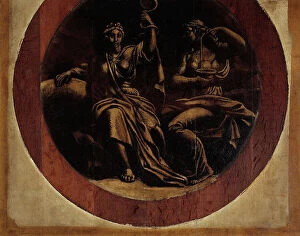Cardinal Virtues Collection
The Cardinal Virtues have long been celebrated as the epitome of moral excellence and righteousness
All Professionally Made to Order for Quick Shipping
The Cardinal Virtues have long been celebrated as the epitome of moral excellence and righteousness. These virtues, which include Prudence, Justice, Temperance, and Fortitude, are depicted in various forms of art throughout history. In the fresco titled "Triumph of Glory announced by Fame standing among the Cardinal Virtues, " painted in 1743, we witness a grand spectacle where Fame proudly proclaims victory while being surrounded by these virtuous figures. This artwork serves as a reminder that true glory can only be achieved through embodying these essential qualities. Another captivating piece is Luca Giordano's oil on canvas painting called "Allegory of the Fortress. " Here we see an allegorical representation showcasing how fortitude acts as a stronghold against adversity and temptation. It reminds us to remain steadfast in our beliefs and principles even when faced with challenges. Stained glass windows also pay homage to the Cardinal Virtues. In one such window depicting a Nativity scene alongside the Virtues themselves, we are reminded that these virtues should guide our actions not just during festive times but every day of our lives. The Raphael Rooms' frescoes bring forth powerful imagery portraying popes positioned between specific virtues. Pope Clement I stands between Moderation and Clemency; Pope Sylvester I finds himself amidst Faith and Religion; Pope Urban I is flanked by Justice and Charity; while Pope Damasus I is placed between Prudence and Peace. These artworks highlight how important it is for leaders to embody these virtues in order to govern with wisdom, fairness, compassion, and tranquility. Additionally, there are paintings like "Prudence" from the late 17th century that depict this particular virtue alone. It emphasizes the importance of careful decision-making based on sound judgment and foresight. Lastly, two remarkable works deserve mention: "Cardinal and Theological Virtues" from 1508-1511 showcases detailed depictions of all four cardinal virtues alongside theological virtues, emphasizing the interconnectedness of moral and spiritual excellence.
















